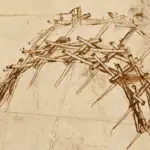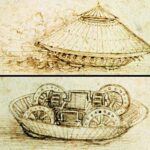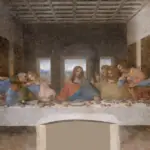Da Vinci Machine Gun
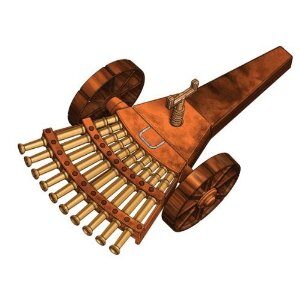
Leonardo da Vinci machine gun model
The Leonardo da Vinci machine gun is a fascinating example of ingenuity and foresight from the Renaissance era. You may find yourself intrigued by the idea of a famous artist contributing to weapons development.
This article will explore how Leonardo da Vinci’s imaginative designs paved the way for future advancements in weaponry.
Leonardo’s machine gun, also known as the 33-barreled organ, was a unique prototype that aimed to solve the slow reloading time of traditional firearms. By arranging multiple barrels in a fan shape, it allowed for rapid succession firing, which was groundbreaking for its time.
Though never built, Leonardo’s design was a precursor to modern automatic firearms.
Beyond just the machine gun, this inventive mind conceived various other war machines, including armored cars and giant crossbows. His work as a military engineer demonstrated his unparalleled ability to merge art with practical technology applications.
Enthusiasts of history and innovation will appreciate how his ideas influence designs in contemporary weapon systems.
Leonardo da Vinci Machine Gun: Historical Context
Leonardo da Vinci’s inventive genius during the Renaissance led to many groundbreaking ideas. His concepts for military technology, such as the machine gun, showcased his imaginative approach to warfare.
Invention during the Renaissance
During the Renaissance, Leonardo da Vinci emerged as one of the most influential figures in art, science, and engineering. His ideas often included significant advancements in technology.
The Leonardo da Vinci machine gun is a prime example of his foresight in modern weaponry. Developed in the 15th century, it proposed a rotating barrel system allowing continuous firing without reloading delays. This idea laid the groundwork for future advancements in artillery.
The Renaissance period was marked by a desire to explore new ideas, and da Vinci’s work reflected this spirit of innovation and curiosity. His visionary designs were not limited to weapons but also included concepts like the Leonardo da Vinci flying machine and the much-discussed Leonardo da Vinci tank.
Leonardo da Vinci’s Military Designs
Leonardo da Vinci’s military designs were ahead of their time, encompassing a range of da Vinci war machines. His work demonstrated a deep understanding of engineering principles, which he applied to create innovative solutions for military challenges.
Among his creations, the Leonardo da Vinci machine gun stood out for its unique approach. Featuring a 33-barreled organ gun, it aimed to improve firing rates and efficiency.
While these designs were revolutionary, they remained conceptual during his lifetime. This fascination with engineering extended beyond weapons, influencing later inventors and paving the way for future advancements in military technology.
Design and Mechanisms
Leonardo da Vinci’s machine gun showcases his remarkable ability to envision complex mechanical systems. This innovation foreshadowed the evolution of modern artillery and highlighted his forward-thinking approach to weaponry.
Technical Specifications
The da Vinci machine gun, often compared to the 33-barrel organ, was a marvel of engineering for its time. It featured multiple small-caliber barrels arranged in a fan shape, allowing for simultaneous firing. This design increased the rate of shots and offered a wide spread of bullets.
A crucial feature was its mobility. The gun’s carriage had wheels, enabling easy movement on the battlefield.
Leonardo’s sketches detailed loading mechanisms and the elevation adjustments necessary for aiming. The concept was to overwhelm enemies with a barrage of firepower, a strategy that still resonates in modern artillery systems.
Innovations in Weaponry
Leonardo’s design was ahead of its time in terms of military technology. His war machines, like this machine gun, were part of a broader vision that included other ingenious inventions such as the Leonardo da Vinci tank and the parachute Leonardo da Vinci.
These devices underscore his understanding of the dynamics of war and defense mechanisms.
The concept of rapid-fire artillery, which was not fully realized until centuries later, highlights Leonardo’s pioneering thought. His machine gun laid the groundwork for future developments in weaponry.
Artistic Representation
Leonardo da Vinci’s machine gun exemplifies his visionary art, blending mechanics and aesthetics. His sketches reflect his innovative approach to engineering and showcase early ideas that predate modern firearms.
Sketches in the Codex Atlanticus
Within the Codex Atlanticus, Leonardo da Vinci created detailed machine gun designs featuring multiple barrels. This collection of drawings, part of the Biblioteca Ambrosiana in Milan, includes a 33-barreled organ gun resembling organ pipes aligned together. These sketches highlight his artistic finesse and his ability to envision warfare technology.
Da Vinci focused on machine guns and explored other military inventions, such as the Leonardo da Vinci cannon and various war machines. His designs were intended to improve firing rates in conflict situations.
Though his machine gun concept was never built, it paved the way for modern engineering discussions.
Leonardo’s work exhibits a seamless fusion of art and science. His drawings stand as artistic representations that reveal his unique perspective on innovation. This blend of creativity and engineering showcases da Vinci’s profound impact on art and technology.
Reproduction and Models
Recreating Leonardo da Vinci’s machine gun involves understanding and adapting his original designs for modern construction. This task appeals to history enthusiasts and engineers who appreciate da Vinci’s ingenuity.
Contemporary Reconstructions
Leonardo da Vinci’s machine gun, sometimes called a rapid-fire crossbow, was detailed in his famous notebook, the Codex Atlanticus. Enthusiasts and historians have recreated this design to explore its practicality. The machine gun aimed to fire multiple shots rapidly, an idea unique to da Vinci’s time.
Producing this machine includes using materials and methods that mirror the 16th-century vision.
The Leonardo3 Museum provides insights into these machines by displaying digital and physical models.
Their exhibits allow visitors to interact with da Vinci’s concepts, ranging from crossbow designs to flying machines. Building these models deepens our appreciation for his inventive genius and showcases how his ideas, such as the Leonardo da Vinci machine gun, remain significant advancements in engineering.
Final Thoughts
Leonardo da Vinci’s machine gun designs showcase his remarkable foresight and creativity in weapon innovation. His concept of a multi-barreled weapon addressed the slow reloading times of early firearms.
Several of his designs, like the 33-barreled organ gun, can be seen as prototypes for modern artillery.
Leonardo’s innovative use of multiple cannons firing in succession demonstrated his deep understanding of battlefield needs.
Despite their potential, these designs mainly remained theoretical due to technological and resource constraints. However, his ideas did influence later generations.
Key Takeaways: Leonardo da Vinci’s ideas on machine guns were ahead of his time, laying the groundwork for future advancements in rapid-fire weaponry. His inventive spirit continues to inspire engineers and inventors today.
Frequently Asked Questions
Leonardo da Vinci’s interest in military technology led him to create designs for various machines. His designs include a machine gun concept known as the 33-barreled organ, but many of his inventions faced challenges in practicality and execution.
Did Leonardo da Vinci make a machine gun?
Leonardo da Vinci designed a concept for a machine gun called the 33-barreled organ. This design featured multiple barrels arranged in rows to allow rapid firing. However, he never actually built a functioning model.
Did the 33-barreled organ work?
The 33-barreled organ was an ambitious design never constructed in da Vinci’s time. The technology and materials available during the Renaissance were insufficient to bring this design to life. However, it remains a concept that demonstrates his innovative thinking.
Did Leonardo da Vinci invent the ballista?
Leonardo da Vinci did not invent the ballista, as it was an ancient missile weapon the Greeks and Romans used. However, he did create designs that improved upon the existing ballista technology. His version featured enhancements for increased power and accuracy.
What military things did Leonardo da Vinci invent?
Leonardo da Vinci designed various military machines, including a tank, a giant crossbow, and a machine gun. He also conceptualized an armored vehicle resembling a modern tank. These designs showcased his creativity and vision for military innovation.
Did any of da Vinci’s machines work?
Many of Leonardo da Vinci’s military machines remained conceptual and were not built during his lifetime. Practical limitations and the complexity of his designs often prevented them from being realized.
How does da Vinci Catapult work?
Leonardo’s catapult design used tension to launch projectiles. It featured a sling that held the projectile, which was then launched by releasing the tension in a coiled rope or spring. This design aimed to enhance the range and power of traditional catapults.
Did Leonardo da Vinci make the first robot?
Leonardo da Vinci is credited with designing a mechanical knight, often regarded as one of the earliest robots. This machine could mimic human motions, such as sitting, standing, and moving its arms. However, it was not built during his lifetime.
Did Leonardo da Vinci invent the grenade?
Leonardo da Vinci did not invent the grenade, but he did sketch designs for explosive devices. One of his ideas was a cylindrical grenade filled with powder. This illustrates his interest in and contributions to early warfare concepts.
Did da Vinci draw a helicopter?
Leonardo da Vinci sketched a design for a flying machine known as the “aerial screw.” This design resembled a primitive helicopter with a sizeable screw-shaped rotor. Though it was never built, it was an early exploration of vertical flight.
What was da Vinci’s tank made of?
Leonardo da Vinci’s tank design was made of wood and featured a protective shell reinforced with metal plates. The vehicle was equipped with various cannons and designed to move on wheels. However, mechanical limitations prevented it from being built.
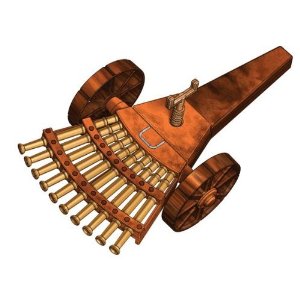
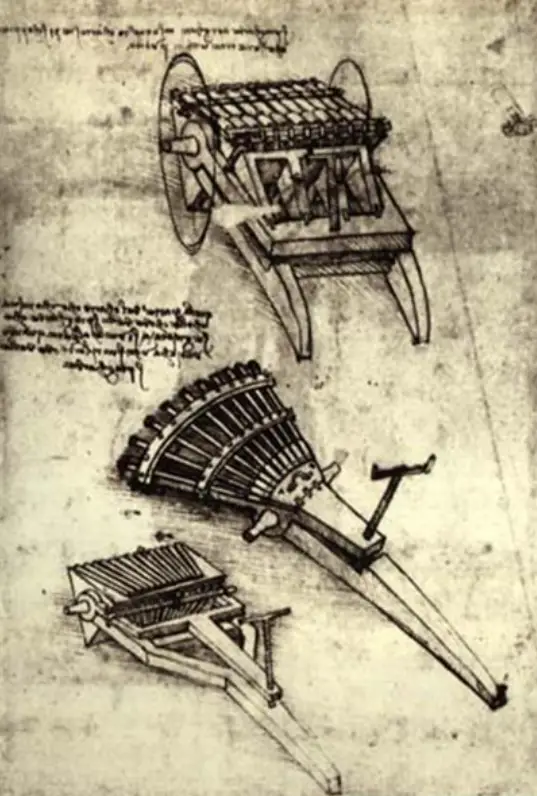
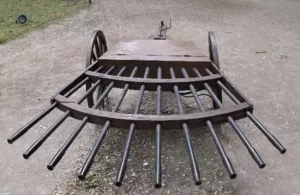
 I’m Leonardo Bianchi, the mind behind Leonardo da Vinci's Inventions. Thanks for visiting.
I’m Leonardo Bianchi, the mind behind Leonardo da Vinci's Inventions. Thanks for visiting. 